
Discover 100% vet-approved, healthy homemade dog treats recipes made with safe, nutritious ingredients. Easy, budget-friendly, and perfect for dogs of all ages and diets!
Healthy Homemade Dog Treats Recipes (Vet Approved)
Introduction to Homemade Dog Treats Recipes
- Importance of homemade dog treats
- Benefits of vet-approved recipes
Why Choose Homemade Dog Treats Over Store-Bought?
- Control over ingredients
- Avoiding harmful preservatives and additives
- Cost-effectiveness
Understanding What Makes a Treat “Vet Approved”
- Key nutritional guidelines
- Ingredients to avoid
- Vet consultation and recommendations
Essential Ingredients for Healthy Dog Treats
- Common vet-recommended ingredients
- Nutritional value of each
- Ingredient sourcing tips
Tools and Equipment You’ll Need
- Kitchen essentials for treat-making
- Optional gadgets to make life easier
Recipe 1 – Peanut Butter & Banana Biscuits
- Ingredients
- Step-by-step instructions
- Nutritional benefits
Recipe 2 – Chicken & Carrot Bites
- Ingredients
- Step-by-step instructions
- Why dogs love this combo
Recipe 3 – Sweet Potato Chews
- Ingredients
- Step-by-step instructions
- Digestive health benefits
Recipe 4 – Pumpkin & Oatmeal Cookies
- Ingredients
- Step-by-step instructions
- Great for sensitive stomachs
Recipe 5 – Salmon & Spinach Patties
- Ingredients
- Step-by-step instructions
- Omega-3 and antioxidant-rich
Storing Your Homemade Treats Safely
- Best storage methods
- Shelf life of different types
- Freezing options
Portion Control and Feeding Frequency
- How many treats are too many?
- Treats as part of a balanced diet
- Weight management tips
Special Considerations for Puppies and Senior Dogs
- Adjusting recipes for age
- Texture and size modifications
- Nutritional adjustments
Allergy-Friendly Treat Alternatives
- Common dog allergens to avoid
- Substitution ideas
- Vet tips for elimination diets
Tips to Make Treat Time Fun and Interactive
- Using treats for training
- Puzzle toys and enrichment
- Bonding through baking
Conclusion
- Summary of benefits
- Encouragement to start making your own treats
FAQs
Healthy Homemade Dog Treats Recipes (Vet Approved)
Introduction to Homemade Dog Treats Recipes
Our furry companions deserve the best—especially when it comes to what they eat. Just like us, dogs thrive on high-quality, nutritious foods that fuel their bodies and support their health. If you’re like most pet parents, you’ve probably glanced at the ingredient list on store-bought dog treats and raised an eyebrow or two. Many commercial treats are packed with preservatives, artificial colors, fillers, and even potential allergens. That’s why making healthy homemade dog treats is one of the best ways to ensure your pup gets safe, delicious, and vet-approved snacks.
These recipes aren’t just tasty—they’re made with ingredients vets approve of for overall health, strong immunity, shiny coats, and happy tails. Whether your dog is a high-energy pup or a mellow senior, you’ll find recipes here that cater to every age, size, and breed. And don’t worry—you don’t need to be a culinary wizard. If you can measure, mix, and bake, you’ve got all the skills you need.
So, tie on that apron, grab a mixing bowl, and get ready to bake some tail-wagging treats your dog will absolutely love!
Why Choose Homemade Dog Treats Over Store-Bought?
Ever read the back of a dog treat package and thought, “What on earth is propylene glycol doing in there?” That’s just one of the many questionable ingredients lurking in commercial dog snacks. Choosing homemade dog treats allows you to eliminate the mystery. You know exactly what’s going into your dog’s body—and more importantly, what’s not.
Here’s why more dog owners are turning to homemade goodies:
1. Total Control Over Ingredients
When you make treats at home, you’re the boss of every ingredient that goes in. Want to skip grains? Go ahead. Need to avoid chicken due to allergies? Not a problem. You get to tailor each recipe to your dog’s dietary needs and preferences.
2. Say Goodbye to Harmful Additives
Preservatives, artificial flavors, and synthetic dyes are common in many commercial treats. Some of these additives are known to trigger allergies or digestive issues in sensitive dogs. Homemade treats eliminate the need for these chemicals entirely.
3. Cost-Effective and Budget Friendly
Believe it or not, making treats at home can actually save you money. Bulk ingredients like oats, pumpkin, and peanut butter go a long way and can be used for multiple batches. You can also repurpose leftovers from your own meals (think: cooked chicken or mashed sweet potato) to whip up quick snacks for your pup.
4. Strengthening the Human-Dog Bond
There’s something incredibly heartwarming about cooking for your dog. Watching them enjoy something you made with your own hands? Pure joy. It’s a fun, feel-good activity that brings you closer together.
5. Ideal for Dogs with Special Diets
Have a pup on a prescription or elimination diet? Homemade treats can be customized to meet strict dietary needs. You can also ensure there are no cross-contaminants from other allergens, something that’s harder to control in a factory setting.
So, homemade isn’t just a cute idea—it’s a smart and healthy choice for any loving dog parent.
Understanding What Makes a Treat “Vet Approved”
So what exactly does “vet-approved” mean when it comes to dog treats? It’s not just a marketing gimmick—it’s a marker of safety, quality, and nutrition.
Here’s what makes a homemade dog treat truly vet-approved:
1. Balanced Nutrition
Vets recommend treats that provide nutritional benefits without excessive calories. A good rule of thumb is that treats should not make up more than 10% of your dog’s daily caloric intake. Vet-approved treats often contain high-quality protein, healthy fats, and natural sources of fiber and vitamins.
2. Clean and Safe Ingredients
Vet-approved recipes steer clear of common canine toxins like chocolate, xylitol, raisins, grapes, onions, garlic, and artificial sweeteners. Instead, they use safe, simple ingredients like pumpkin, carrots, sweet potatoes, and lean meats.
3. Consideration for Special Needs
Some dogs require low-fat diets due to pancreatitis, while others need grain-free options for sensitive stomachs. Vets recommend adjusting recipes to suit the dog’s individual health status, including any allergies, age-related needs, or chronic conditions.
4. Digestibility and Texture
Treats should be easy for dogs to chew and digest. This is especially important for puppies with developing teeth and seniors with dental issues. Vet-approved treats often include softer textures or can be baked to be easily broken into smaller pieces.
5. Caloric Awareness
Obesity is a growing problem in dogs. Vets are keen on keeping treats low in calories but high in nutritional value. They suggest using treats strategically for training and rewarding good behavior, not as meal replacements.
Pro tip: Before introducing a new treat—even if it’s homemade—it’s always a good idea to run it by your vet, especially if your dog has medical conditions or allergies.
Essential Ingredients for Healthy Dog Treats
When it comes to making homemade dog treats, not all kitchen staples are created equal. Some ingredients are safe, healthy, and even beneficial—others can be downright dangerous. Let’s talk about the must-have ingredients you’ll want in your treat-making toolkit.
1. Pumpkin (Plain, Not Pie Filling)
Pumpkin is a digestive superhero. Rich in fiber and low in fat, it helps with both diarrhea and constipation. Plus, dogs usually love the taste!
2. Sweet Potatoes
Loaded with beta-carotene and fiber, sweet potatoes are a great source of slow-digesting carbs that provide lasting energy.
3. Peanut Butter (Unsalted & Xylitol-Free)
Peanut butter adds protein and healthy fats. Just make sure it’s free from xylitol, a toxic sweetener for dogs.
4. Carrots and Spinach
These veggies pack in vitamins like A, K, and C. They’re great chopped finely or pureed into treats for picky eaters.
5. Oats and Brown Rice
Wholesome grains like these provide fiber, protein, and are generally easy on the stomach.
6. Lean Meats: Chicken, Salmon, Turkey
Great protein sources. Make sure to use plain cooked meat without added salt, onion, or garlic.
7. Eggs
Eggs provide protein, amino acids, and healthy fats. They also act as a binder in baked treats.
Avoid ingredients like onions, garlic, chocolate, grapes, raisins, macadamia nuts, and artificial sweeteners—these are toxic to dogs even in small amounts.
Tools and Equipment You’ll Need
Don’t worry—you won’t need a fancy dog treat factory in your kitchen. A few basic tools are all you need to whip up batch after batch of tasty snacks.
Essential Tools
- Mixing bowls: Large and medium sizes work well.
- Measuring cups and spoons: Accuracy matters!
- Baking sheets: Non-stick or lined with parchment paper.
- Rolling pin: Especially helpful for biscuit-style treats.
- Cookie cutters: Bone-shaped ones are fun but not necessary.
Optional But Useful
- Food processor: Speeds up ingredient prep.
- Dehydrator: Great for chewy treats like jerky or sweet potato strips.
- Silicone baking molds: Perfect for fun shapes and easy removal.
- Airtight containers: For storing your treats safely.
With your kitchen stocked and your pup drooling, you’re ready to start baking.
Recipe 1 – Peanut Butter & Banana Biscuits
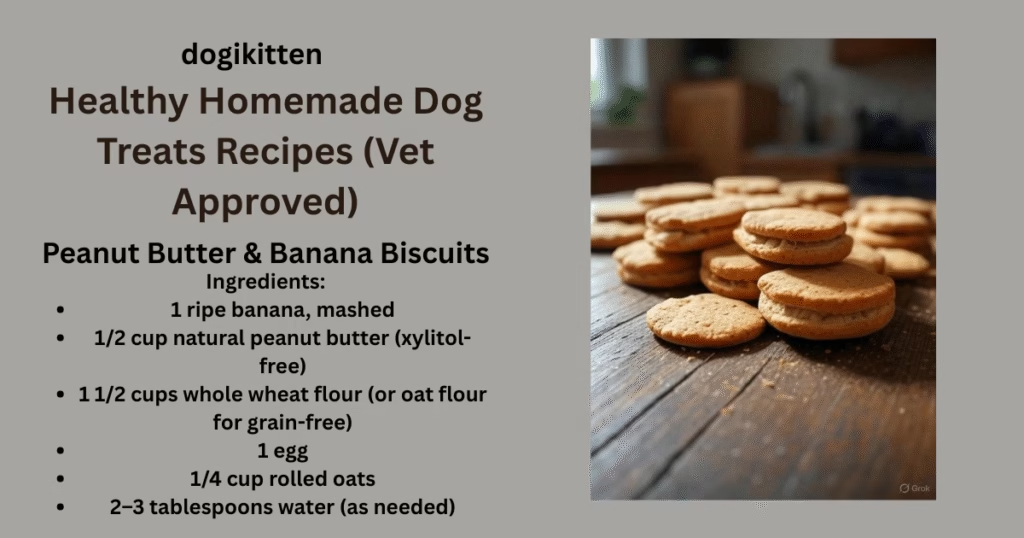
Few things in life are as universally adored by dogs as the heavenly combo of peanut butter and bananas. This recipe brings together these two delicious and nutritious ingredients in a simple biscuit form that’s easy to bake and even easier for your pup to devour.
Ingredients:
- 1 ripe banana, mashed
- 1/2 cup natural peanut butter (xylitol-free)
- 1 1/2 cups whole wheat flour (or oat flour for grain-free)
- 1 egg
- 1/4 cup rolled oats
- 2–3 tablespoons water (as needed)
Instructions:
- Preheat your oven to 350°F (175°C).
- In a large bowl, mix the mashed banana and peanut butter until smooth.
- Add in the egg and oats, then gradually mix in the flour.
- Add water one tablespoon at a time if the dough is too dry.
- Roll the dough out on a lightly floured surface to about 1/4-inch thick.
- Cut into shapes using cookie cutters or simply slice into squares.
- Place the biscuits on a baking sheet lined with parchment paper.
- Bake for 15–20 minutes or until golden brown.
- Let them cool completely before serving.
Nutritional Benefits:
- Bananas are packed with potassium, fiber, and vitamin C, making them great for digestion and muscle health.
- Peanut butter is an excellent source of protein and healthy fats, but make sure it’s natural and doesn’t contain any added sugar or artificial sweeteners.
- Oats and whole wheat flour add fiber and help the treats stay crunchy.
These biscuits are soft enough for older dogs but firm enough to encourage chewing for dental health. They’re a perfect training treat or midday snack!
Recipe 2 – Chicken & Carrot Bites
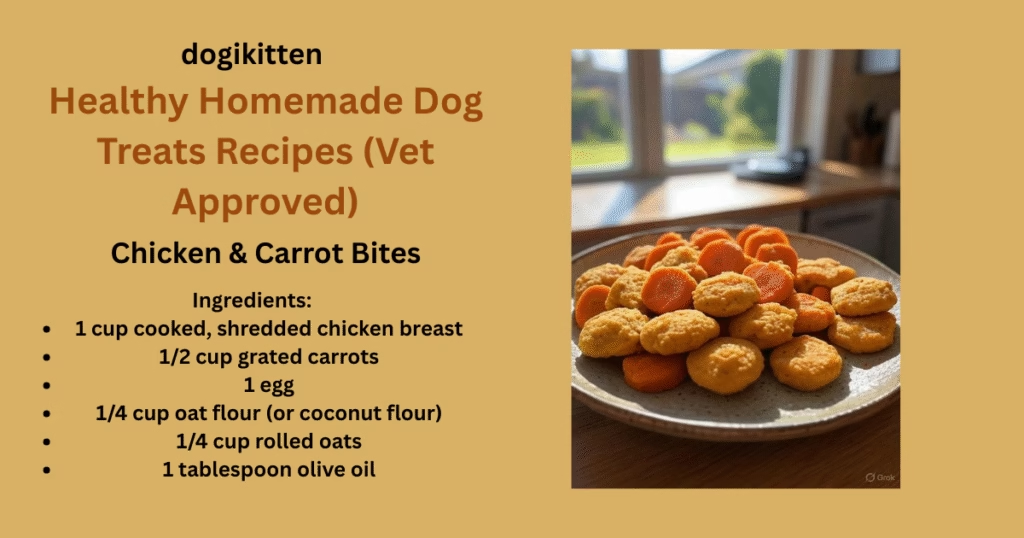
Protein meets crunch in this savory treat that smells so good, you might be tempted to try one yourself (don’t worry—we won’t judge). These bites are packed with lean chicken and fresh carrots for a protein-rich, vitamin-packed snack.
Ingredients:
- 1 cup cooked, shredded chicken breast
- 1/2 cup grated carrots
- 1 egg
- 1/4 cup oat flour (or coconut flour)
- 1/4 cup rolled oats
- 1 tablespoon olive oil
Instructions:
- Preheat the oven to 350°F (175°C).
- Mix all ingredients in a large bowl until well combined.
- Roll the mixture into small balls or press into silicone molds.
- Place on a lined baking sheet and flatten slightly with your hand.
- Bake for 20–25 minutes or until firm and slightly golden.
- Cool completely before storing in an airtight container.
Why Dogs Love This Combo:
- Chicken is a great low-fat protein that supports muscle health and energy.
- Carrots offer a natural crunch and are loaded with beta-carotene, which helps with vision and immune health.
- Olive oil adds a dose of omega fatty acids for a shiny coat.
These treats are fantastic for dogs of all sizes and can be broken into smaller bits for training or rewards.
Recipe 3 – Sweet Potato Chews

Looking for a one-ingredient treat that’s as healthy as it is satisfying? Say hello to sweet potato chews. These chewy strips are a doggy favorite and are great for dental health. Best part? They’re incredibly easy to make.
Ingredients:
- 1–2 large sweet potatoes
Instructions:
- Preheat your oven to 250°F (120°C).
- Wash and peel the sweet potatoes.
- Slice them lengthwise into thin, even strips (about 1/4-inch thick).
- Place the slices on a baking rack or parchment-lined baking sheet.
- Bake for 2.5 to 3 hours, flipping once halfway through.
- Let cool completely before serving.
Digestive Health Benefits:
- Sweet potatoes are rich in dietary fiber, beta-carotene, and complex carbohydrates.
- These chews are great for dogs with sensitive stomachs and can help regulate digestion.
- The chewy texture can help clean teeth naturally and satisfy the need to gnaw.
Store these in an airtight container for up to two weeks or freeze them for longer shelf life.
Recipe 4 – Pumpkin & Oatmeal Cookies
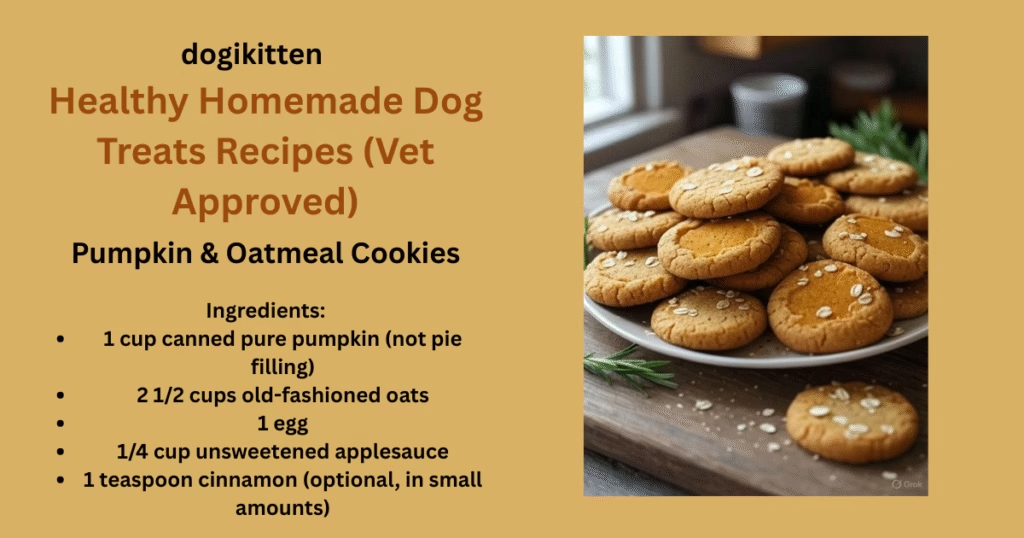
Pumpkin isn’t just for fall—it’s a year-round superfood for dogs. Combined with oats, it creates a soothing, stomach-friendly treat that even the pickiest pups adore.
Ingredients:
- 1 cup canned pure pumpkin (not pie filling)
- 2 1/2 cups old-fashioned oats
- 1 egg
- 1/4 cup unsweetened applesauce
- 1 teaspoon cinnamon (optional, in small amounts)
Instructions:
- Preheat oven to 350°F (175°C).
- Pulse oats in a food processor until they become a coarse flour.
- Mix all ingredients in a large bowl until a sticky dough forms.
- Drop spoonfuls onto a parchment-lined baking sheet and flatten slightly.
- Bake for 20–25 minutes until the edges are golden and firm.
- Let cool completely before serving or storing.
Great for Sensitive Stomachs:
- Pumpkin supports healthy digestion and is rich in vitamin A and antioxidants.
- Applesauce provides a subtle sweetness without added sugar.
- Oats offer slow-releasing energy and are easy on the tummy.
These are perfect for dogs prone to upset stomachs or on a bland diet recovery plan. Just keep portions small and watch your dog enjoy every bite.
Recipe 5 – Salmon & Spinach Patties
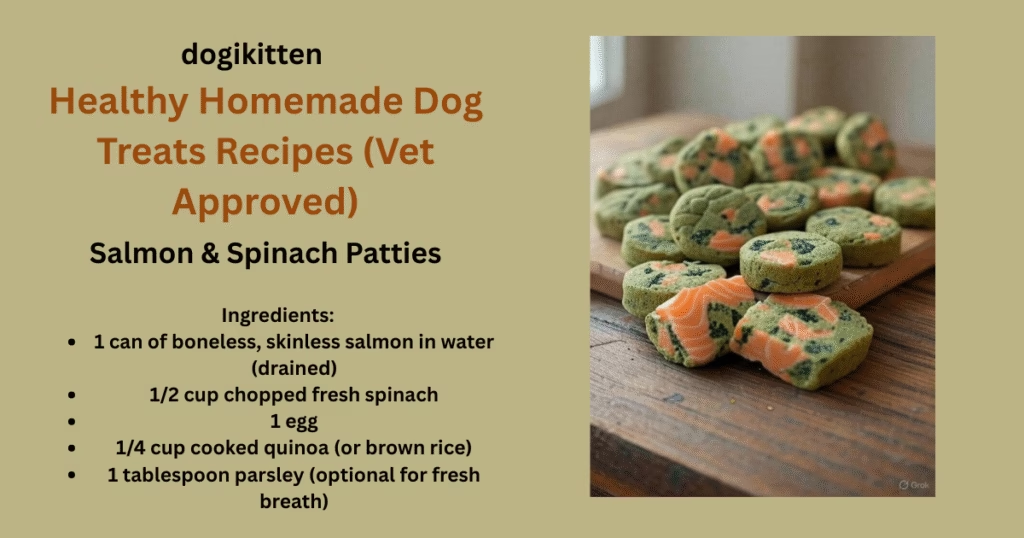
These protein-packed patties are like gourmet dog food in treat form. With salmon bringing omega-3s and spinach delivering a dose of antioxidants, they support heart health, skin, coat, and more.
Ingredients:
- 1 can of boneless, skinless salmon in water (drained)
- 1/2 cup chopped fresh spinach
- 1 egg
- 1/4 cup cooked quinoa (or brown rice)
- 1 tablespoon parsley (optional for fresh breath)
Instructions:
- Preheat oven to 350°F (175°C).
- In a bowl, mash the salmon with a fork.
- Stir in the spinach, quinoa, parsley, and egg until combined.
- Form into small patties and place on a lined baking sheet.
- Bake for 20–25 minutes or until firm and lightly browned.
- Cool and refrigerate in an airtight container.
Omega-3 and Antioxidant-Rich Benefits:
- Salmon is rich in omega-3 fatty acids, which support joint health and reduce inflammation.
- Spinach adds iron, fiber, and antioxidants for immunity and vitality.
- Quinoa provides a complete protein and is gluten-free, making it perfect for dogs with grain sensitivities.
Serve these as a protein-packed treat or a topper to spice up dinner.
Storing Your Homemade Treats Safely
Now that you’ve baked up a storm, let’s talk about keeping those treats fresh, tasty, and safe for your dog. Unlike store-bought snacks, homemade treats don’t have preservatives, which is great for health but requires smarter storage.
1. Cooling is Crucial
Before storing any treats, make sure they are fully cooled. Trapping warmth inside an airtight container can lead to condensation—and that means mold. Let them rest on a wire rack for at least 30 minutes after baking.
2. Airtight Containers
Store treats in airtight glass jars or BPA-free plastic containers to maintain freshness. Silicone food-grade containers are also a good option. If you’re using bags, go with resealable zip-top ones.
3. Refrigeration and Freezing Tips
- Refrigerate soft, moist treats like patties or meat-based bites. They’ll last about a week.
- Freeze extra treats in small batches. Use parchment paper between layers to prevent sticking. Most treats will stay good in the freezer for 2–3 months.
4. Know the Shelf Life
Here’s a quick reference:
| Treat Type | Room Temp | Refrigerated | Frozen |
|---|---|---|---|
| Biscuits | 7–10 days | Up to 3 weeks | 2–3 months |
| Soft/Meaty Treats | 2–3 days | Up to 1 week | 2–3 months |
| Dehydrated Chews | 2–3 weeks | Optional | 3–4 months |
5. Signs a Treat Has Gone Bad
- Mold spots or fuzzy growth
- Sour or foul smell
- Change in texture (slimy or too hard)
- Your dog refuses to eat it (always trust their nose!)
Keeping treats fresh means they’re safer and more appealing to your dog, and you’ll waste less of your homemade goodness.
Portion Control and Feeding Frequency
Homemade treats may be healthy, but that doesn’t mean unlimited snacking is a good idea. Just like humans, dogs can gain weight if they eat too many calories—even from healthy sources. So how do you strike a balance?
1. Follow the 10% Rule
Veterinarians recommend that treats should make up no more than 10% of your dog’s daily calorie intake. If your dog needs 600 calories per day, that means treats should max out at 60 calories.
2. Know Your Dog’s Size and Needs
Here’s a rough guide to daily treat limits:
| Dog Size | Daily Calories | Max Treat Calories |
|---|---|---|
| Small (5–20 lbs) | 200–400 | 20–40 |
| Medium (20–50 lbs) | 400–900 | 40–90 |
| Large (50+ lbs) | 900–1500 | 90–150 |
If you’re not sure, consult your vet for a tailored recommendation.
3. Use Treats Strategically
- Training sessions: Break larger treats into smaller bits to avoid overfeeding.
- Mental stimulation: Hide a few in puzzle toys or treat-dispensing balls.
- Reinforcement: Use treats to encourage good behavior or calm anxiety during nail trims and vet visits.
4. Monitor Your Dog’s Weight
Weigh your dog regularly or monitor their body condition. If they’re getting pudgy, reduce treat portions or switch to lower-calorie options like frozen green beans or apple slices.
Moderation doesn’t mean deprivation—it means giving treats with intention and care.
Special Considerations for Puppies and Senior Dogs
Just like people, dogs at different life stages have different nutritional needs and physical abilities. That means one-size-fits-all treats don’t always cut it. Whether you’re spoiling a bouncy puppy or a wise old friend, here’s how to adjust your homemade treats.
1. Puppies
- Smaller is better: Puppies have tiny mouths and teeth. Go for soft, bite-sized snacks.
- High protein and fat: Growing pups need more calories and nutrients. Recipes with eggs, chicken, and peanut butter are ideal.
- Avoid allergens early on: Introduce new ingredients one at a time to monitor reactions.
- Watch the salt: Their kidneys are still developing, so keep sodium to a minimum.
2. Senior Dogs
- Soft textures: Aging dogs may have dental issues or missing teeth. Bake treats until just tender or use dehydrated options soaked in water.
- Low-fat recipes: Older dogs often have slower metabolisms. Lean proteins and fibrous ingredients like pumpkin are easier to digest.
- Joint health boosters: Consider recipes with ingredients like salmon (omega-3s) or turmeric (anti-inflammatory).
3. Adjusting Recipes
- Replace whole wheat flour with oat or coconut flour for easier digestion.
- Add a spoon of plain yogurt for probiotics and calcium.
- Bake less time for softer cookies.
Tailoring treats for different ages shows just how much you care—and helps your pup enjoy snacks comfortably at every stage of life.
Allergy-Friendly Treat Alternatives
Allergies in dogs are more common than you might think. The good news? You can still make your furry friend delicious, homemade treats with safe, allergy-friendly ingredients.
1. Common Dog Allergens to Avoid
- Chicken
- Beef
- Dairy
- Wheat
- Corn
- Soy
- Eggs (in some rare cases)
2. Allergy-Friendly Ingredient Swaps
| Common Allergen | Safe Alternatives |
|---|---|
| Wheat flour | Oat flour, coconut flour |
| Chicken/Beef | Turkey, salmon, venison |
| Eggs | Unsweetened applesauce, flaxseed + water |
| Dairy | Coconut milk, almond milk (unsweetened, xylitol-free) |
3. Sample Allergy-Friendly Recipe
Pumpkin-Turkey Treats
- 1/2 cup pumpkin puree
- 1/2 cup cooked ground turkey
- 1 cup oat flour
- 1 tablespoon ground flaxseed
- Mix, shape, bake at 350°F for 20 mins
4. Consult Your Vet
Before making major changes to your dog’s diet, especially if they have diagnosed allergies or sensitivities, check with your vet or a veterinary nutritionist.
Homemade allergy-friendly treats allow you to avoid risky ingredients while still pampering your pup with something special.
Tips to Make Treat Time Fun and Interactive
Giving your dog a treat doesn’t have to be boring! With a little creativity, treat time can turn into quality bonding, brain games, and tail-wagging excitement.
1. Turn Treats Into a Game
- Hide and seek: Hide treats around the house or yard and let your dog use their nose to find them.
- Treat puzzles: Use interactive toys that challenge your dog to solve puzzles before earning a reward.
- DIY snuffle mats: Sprinkle treats in fleece mats or old towels for sniff-and-search fun.
2. Training Opportunities
- Use treats during obedience training—sit, stay, come, heel—these all become more effective when a reward is involved.
- Keep treats small and breakable to avoid overfeeding during long sessions.
3. Celebrate With Treats
- Host a “Gotcha Day” party with homemade dog cakes or cookies.
- Bake holiday-themed treats (pumpkin bones for fall, heart-shaped snacks for Valentine’s Day).
4. Bonding Through Baking
Get the whole family involved in treat-making. Kids can mix, shape, and decorate (with dog-safe ingredients of course). Your pup will love the attention—and the results.
Treats are more than food—they’re a form of communication, training, love, and fun.
Conclusion
Making healthy homemade dog treats isn’t just a fun hobby—it’s an act of love that shows your furry friend just how much you care. Whether you’re baking crunchy biscuits, chewy bites, or savory patties, every treat you create in your kitchen is a healthier, safer, and more flavorful alternative to what you’ll find on store shelves. More importantly, these treats are tailored specifically to your dog’s needs—free from harmful chemicals, full of nutritious goodness, and made with ingredients you can actually pronounce.
Throughout this guide, we’ve explored the benefits of going homemade, covered what makes a treat truly vet-approved, and shared five delicious and wholesome recipes. We’ve also dived deep into safe ingredient choices, proper storage, portion control, and ways to accommodate dogs of all ages and allergies. Armed with this knowledge, you’re now ready to ditch the preservative-laden snacks and start baking batches of love from scratch.
One of the best things about making treats at home is the connection it builds between you and your dog. Every tail wag, happy bark, and drool-drenched smile is a thank-you. And who doesn’t love being appreciated like that?
So, grab those mixing bowls, preheat that oven, and get creative. Your pup is counting on you—and trust us, they’ll know the difference between a store-bought snack and a homemade masterpiece made just for them.
And hey, don’t forget to taste (okay, sniff) the joy that comes from making your dog healthier, happier, and more loved with every single bite.
FAQs
1. How long do homemade dog treats last?
Homemade dog treats typically last 5–10 days at room temperature if they’re dry and crunchy. For soft treats or those with meat, refrigeration is essential and extends freshness to up to 1 week. Most treats can be frozen for 2–3 months if sealed properly in an airtight container.
2. Can I freeze homemade dog treats?
Absolutely! Freezing is a great way to store treats in bulk. Just make sure the treats are completely cooled before freezing, and use parchment paper between layers to prevent sticking. Thaw in the refrigerator or at room temperature before serving.
3. What ingredients are toxic to dogs?
Always avoid the following ingredients in any treat:
- Chocolate
- Xylitol (a sugar substitute found in some peanut butter)
- Grapes and raisins
- Onions and garlic
- Macadamia nuts
- Caffeine
Even small amounts can be dangerous, so double-check labels before using anything.
4. How many treats can I give my dog daily?
The general rule is that treats should make up no more than 10% of your dog’s daily calories. This varies based on your dog’s weight, activity level, and diet. When in doubt, err on the side of fewer treats and supplement with healthy options like carrot sticks or apple slices.
5. Are these recipes safe for all dog breeds?
Yes, the recipes shared here are made using ingredients generally considered safe for all dog breeds. However, every dog is unique. If your pup has specific health issues, allergies, or is on a restricted diet, consult your vet before introducing any new treats—even homemade ones.










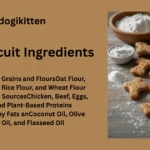
2 thoughts on “Healthy Homemade Dog Treats Recipes (Vet Approved)”